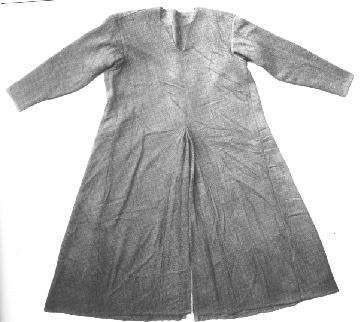
The Moselund Tunic
The Moselund body was found in 1884, and the woolen costume was sewn together to resemble a trouser suit of sorts with a matching cape. In 1938 a new examination showed that all the pieces combined to one garment, and the kirtle was reconstructed.It is dated to the early Middle Ages through pollen-analysis and based on its cut, and the fabric is remarkably well preserved. It appears to have been quite new when it ended up in the Bog, there is no wear and no mendings. The weave is a 2/1 twill. The fabric had been fulled. A recent examination has dated the tunic to circa 1100.
The tunic is of a kind known in Iceland as 'bladkjortel'. The slit made the garment comfortable in movement, and suitable for working or riding in. The sides could be gathered up into the belt for additional freedom of movement, and could also be used as 'pockets' to carry things in. However there were no seams preserved to prove that this is the case.
The cut of the shoulder area is unusual. The back is much wider than the front, which gives it quite a sofisticated, cape like look. The gores are pleated at the top.

Bibliography:
Ancient Danish Textiles from Bogs and Burials, Margrethe Hald, The National Museum of Denmark, Copenhagen 1980.
Bockstensmannen och hans dräkt, Margareta Nockert m.fl. Hallands länsmuseer, Halmstad och Varberg, 1997.
Personal communication, Else Ostergaard, at a visit at Brede in September 2002.